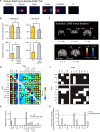Dynamically Allocated Hub in Task-Evoked Network Predicts the Vulnerable Prefrontal Locus for Contextual Memory Retrieval in Macaques
- PMID: 26125513
- PMCID: PMC4488377
- DOI: 10.1371/journal.pbio.1002177
Dynamically Allocated Hub in Task-Evoked Network Predicts the Vulnerable Prefrontal Locus for Contextual Memory Retrieval in Macaques
Abstract
Neuroimaging and neurophysiology have revealed that multiple areas in the prefrontal cortex (PFC) are activated in a specific memory task, but severity of impairment after PFC lesions is largely different depending on which activated area is damaged. The critical relationship between lesion sites and impairments has not yet been given a clear mechanistic explanation. Although recent works proposed that a whole-brain network contains hubs that play integrative roles in cortical information processing, this framework relying on an anatomy-based structural network cannot account for the vulnerable locus for a specific task, lesioning of which would bring impairment. Here, we hypothesized that (i) activated PFC areas dynamically form an ordered network centered at a task-specific "functional hub" and (ii) the lesion-effective site corresponds to the "functional hub," but not to a task-invariant "structural hub." To test these hypotheses, we conducted functional magnetic resonance imaging experiments in macaques performing a temporal contextual memory task. We found that the activated areas formed a hierarchical hub-centric network based on task-evoked directed connectivity, differently from the anatomical network reflecting axonal projection patterns. Using a novel simulated-lesion method based on support vector machine, we estimated severity of impairment after lesioning of each area, which accorded well with a known dissociation in contextual memory impairment in macaques (impairment after lesioning in area 9/46d, but not in area 8Ad). The predicted severity of impairment was proportional to the network "hubness" of the virtually lesioned area in the task-evoked directed connectivity network, rather than in the anatomical network known from tracer studies. Our results suggest that PFC areas dynamically and cooperatively shape a functional hub-centric network to reallocate the lesion-effective site depending on the cognitive processes, apart from static anatomical hubs. These findings will be a foundation for precise prediction of behavioral impacts of damage or surgical intervention in human brains.
Conflict of interest statement
The authors have declared that no competing interests exist.
Figures






Comment in
-
Network Hubs in the Brain Have the Biggest Impact on Behavior.PLoS Biol. 2015 Jun 30;13(6):e1002178. doi: 10.1371/journal.pbio.1002178. eCollection 2015 Jun. PLoS Biol. 2015. PMID: 26125561 Free PMC article.
Similar articles
-
Network Hubs in the Brain Have the Biggest Impact on Behavior.PLoS Biol. 2015 Jun 30;13(6):e1002178. doi: 10.1371/journal.pbio.1002178. eCollection 2015 Jun. PLoS Biol. 2015. PMID: 26125561 Free PMC article.
-
Functional network in the prefrontal cortex during episodic memory retrieval.Neuroimage. 2005 Jul 1;26(3):932-40. doi: 10.1016/j.neuroimage.2005.03.004. Epub 2005 Apr 15. Neuroimage. 2005. PMID: 15955503 Clinical Trial.
-
Functional and Neuroanatomic Specificity of Episodic Memory Dysfunction in Schizophrenia: A Functional Magnetic Resonance Imaging Study of the Relational and Item-Specific Encoding Task.JAMA Psychiatry. 2015 Sep;72(9):909-16. doi: 10.1001/jamapsychiatry.2015.0276. JAMA Psychiatry. 2015. PMID: 26200928 Free PMC article.
-
Functional neuroimaging studies of prospective memory: what have we learnt so far?Neuropsychologia. 2011 Jul;49(8):2246-57. doi: 10.1016/j.neuropsychologia.2011.02.014. Epub 2011 Feb 15. Neuropsychologia. 2011. PMID: 21329712 Review.
-
The functional neuroanatomy of working memory: contributions of human brain lesion studies.Neuroscience. 2006 Apr 28;139(1):51-8. doi: 10.1016/j.neuroscience.2005.09.018. Epub 2005 Dec 15. Neuroscience. 2006. PMID: 16352402 Review.
Cited by
-
Dynamic Reconfiguration of Functional Topology in Human Brain Networks: From Resting to Task States.Neural Plast. 2020 Sep 8;2020:8837615. doi: 10.1155/2020/8837615. eCollection 2020. Neural Plast. 2020. PMID: 32963519 Free PMC article.
-
Noninvasive intervention by transcranial ultrasound stimulation: Modulation of neural circuits and its clinical perspectives.Psychiatry Clin Neurosci. 2024 May;78(5):273-281. doi: 10.1111/pcn.13663. Epub 2024 Mar 20. Psychiatry Clin Neurosci. 2024. PMID: 38505983 Free PMC article. Review.
-
Multiple insular-prefrontal pathways underlie perception to execution during response inhibition in humans.Nat Commun. 2024 Dec 3;15(1):10380. doi: 10.1038/s41467-024-54564-9. Nat Commun. 2024. PMID: 39627197 Free PMC article.
-
Network Hubs in the Brain Have the Biggest Impact on Behavior.PLoS Biol. 2015 Jun 30;13(6):e1002178. doi: 10.1371/journal.pbio.1002178. eCollection 2015 Jun. PLoS Biol. 2015. PMID: 26125561 Free PMC article.
-
Hub-driven remote synchronization in brain networks.Sci Rep. 2017 Sep 4;7(1):10403. doi: 10.1038/s41598-017-09887-7. Sci Rep. 2017. PMID: 28871158 Free PMC article.
References
-
- Milner B, Petrides M. (1984) Behavioural effects of frontal-lobe lesions in man. Trends Neurosci 7(11): 403–407.
-
- Shimamura AP, Janowsky JS, Squire LR (1991) What is the role of frontal lobe damage in memory disorders? In Levin HS, Eisenberg HM, Benton AL, editors. Frontal Lobe Functioning and Dysfunction. New York: Oxford University Press; pp. 173–195.
-
- Miyashita Y. (2004) Cognitive memory: Cellular and network machineries and their top-down control. Science 306(5695): 435–440. - PubMed
Publication types
MeSH terms
LinkOut - more resources
Full Text Sources
Other Literature Sources
Medical
Miscellaneous

